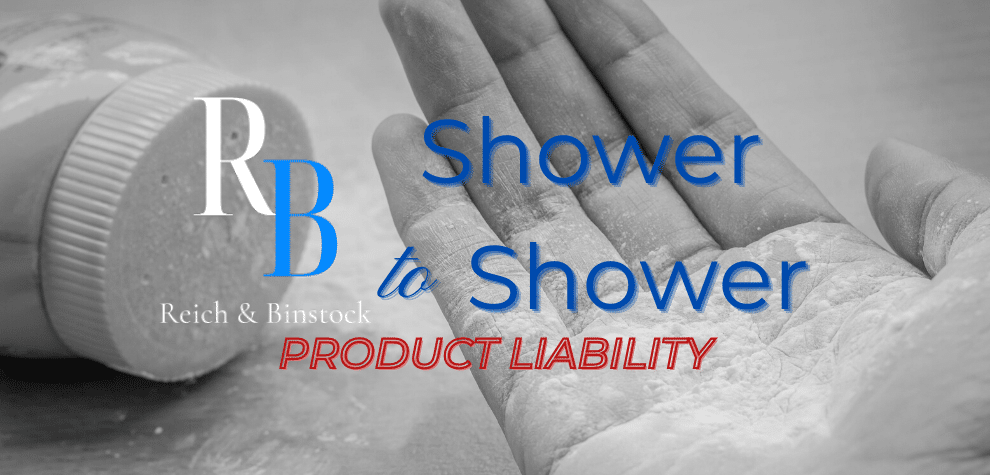Is Talcum Powder Used in Shower to Shower?
Johnson & Johnson invented infant powder in 1893. The firm was in its initial decade of operation when it began marketing Johnson’s Baby Powder. Several things improved for the corporation as it extended its goods and grew to be one of the world’s largest pharmaceutical companies. Johnson & Johnson’s talcum-based powder goods continued to thrive as the firm grew into a multibillion-dollar corporation. Shower to Shower Powder was one of its more popular products.
Talcum powder was not at all exclusively for newborns by 1985. The New York Times revealed just prior to Johnson & Johnson’s centennial that the firm’s baby powder was largely used among adults. It was no surprise when the corporation began manufacturing talcum powder under the age-appropriate label Shower to Shower.
Is Talc Powder Used in Shower to Shower Causing Cancer?
So, does talc cause cancer? Talcum powder is incorporated in all Shower to Shower products. Shower to Shower has also been connected to ovarian cancer, the same as its talc-based baby powder equivalent.
Johnson & Johnson discreetly stated in May 2020 that it would discontinue offering all talc-based goods in the United States, such as Shower to Shower. It claimed a loss of demand as the basis for ceasing selling one of their most significant legacy goods. Simultaneously, the business was undergoing a slew of lawsuits in the United States for their talcum goods. It has not, however, halted foreign exports of talc-based powders.
Cancer triggered by Shower to Shower might include:
- Bloating or swelling in the abdomen
- Feeling full too soon after eating
- Weight loss
- Pelvic pain
- Changes in bowel movement or constipation
- Frequent urination
It’s critical to consult a doctor right away if you’ve been suffering from any of the symptoms listed above. Following that, contact our talcum powder lawsuit attorneys of Reich & Binstock LLP for assistance at 713-622-7271.
What Is Talcum Powder?
Talcum powder is produced from the mineral talc, which is mostly composed of magnesium, silicon, and oxygen. This powder is known to absorb moisture efficiently and reduce friction and chafing as a powdery substance, rendering it excellent for making the skin dry and preventing diaper rash. It’s found in a variety of consumer items, including infant powder, adult body and face powder, and a variety of other cosmetics.
Some talc carries asbestos in its naturally occurring mineral state, which is recognized to cause malignancies and cancers in or outside of the lungs, resulting in breathing problems and more issues. The Cosmetic, Toiletry, and Fragrances Association (CTFA), a trade group that represents the cosmetic industry and personal care products sector, established voluntary standards in 1976. These standards declared that any talc used within cosmetic products in the United States must be devoid of measurable quantities of asbestos.
The most common sources of worry concerning a possible relationship between talcum powder and cancer have been:
- Someone who deals with talc particles for a long time would be at a greater lung cancer risk due to inhaling them.
- Women who use talcum powder around their genital region on a daily basis have a higher threat of ovarian cancer.
Is There a Connection Between Asbestos and Talc?
Asbestos is a collection of minerals extracted in the same way as talc is. It’s frequently discovered near talc. When talc is mined and processed, it might combine with asbestos.
Asbestos has been tied to an increased likelihood of cancer in those who inhale it. As a result, it’s critical for cosmetics businesses to pick mining sites carefully and analyze the talc on a routine basis, specifically for asbestos. A prominent cosmetics trade association released rules in 1976 stating that any and all cosmetic products sold in the United States must be free of measurable quantities of asbestos.
Is It True That Talcum Powder Causes Cancer?

It’s incredibly vital to discern between the cross-contamination of asbestos contamination in talc and asbestos-free talc product in discussing if talcum powder is correlated to cancer. When asbestos-containing talc is breathed in, it is widely believed to develop cancer. The proof for asbestos-free talc is slightly more ambiguous with mixed findings.
To determine if a material or contact with it results in cancer, researchers employ two kinds of research:
- Lab studies: Animals are introduced to a substance in laboratory tests to discover if it creates tumors or other medical complications. Researchers may test the material on normal cells in a lab dish to determine if it triggers the same alterations identified in cancer cells. Although it isn’t always apparent whether the findings from these investigations will translate to humans, lab tests are an excellent approach to see if a material has the potential to cause cancer.
- Studies in people: Human studies look at cancer risk in diverse populations of individuals. Research like this may evaluate the risk of developing cancer in an exposed group to a product and the risk in a group not subjected to it. Or, it could contrast it to the risk predicted in the overall population. However, since numerous other factors may influence the outcomes, it can be difficult to tell what these research findings signify.
When trying to find out if anything has carcinogenic risks or is linked to cancer, experts look at both lab-based and human studies for adequate evidence.
Is There a Cancer Connection?
Talcum powder was associated with cancer in 1971, according to studies. J&J’s talcum-based powders were revealed to possess asbestos, a material that can cause mesothelioma when breathed in. Then researchers discovered that females who had been using talc-containing baby powder in their genital area had a higher risk of ovarian cancer.
Ovarian cancer is rare. In reality, ovarian cancer affects barely 3% of all women diagnosed with cancer. Despite this, a study published in the Cancer Prevention Research Journal indicated that females who had utilized talcum powder goods in their genital area had a 41% increased risk of getting ovarian cancer.
Shower to Shower’s relation to cancers was contested by Johnson & Johnson over decades, arguing that talcum powder usage among ovarian cancer patients had been an overstated coincidence. The corporation even refused to put a warning label on talc goods, stating that doing so would confuse buyers. However, in 2019, studies revealed that talcum could cause mutated cells inside the fallopian tubes prior to reaching the ovaries, triggering genetic abnormalities that contribute to cancer in the ovaries.
This suggests that experts may have uncovered the reason behind the rise in ovarian cancer for women that utilize Shower to Shower.
Reuters uncovered in a 2018 examination that Johnson & Johnson has known about the dangers of Shower to Shower and similar goods for decades. But, while its scientists, law firms and attorneys, and executives sought to figure out what to do, they managed to keep the matter private and hidden from authorities. The corporation would not make a significant judgment until 2020.
The Cancer Risk of Talcum Powder

In comparing risks of cancer, it’s important to distinguish between talc that contains asbestos and talc that does not. According to researchers, those who inhale talc containing asbestos are more likely to develop cancer, particularly if done so on a frequent basis. Asbestos is classified as carcinogenic by the World Health Organization’s International Agency for Research on Cancer.
Questions concerning talc lacking asbestos, on the other hand, are more complicated. Two important concerns have been investigated by researchers:
- Is it possible to develop lung cancer from talc inhalation on a frequent basis?
The majority of individuals will say no. There seems to be no evidence that using talc-based baby powder or any kind of cosmetic talcum powder that is easier to inhale increases your risk of lung cancer.
Those that work in talc mining and processing had a noticeably greater risk, according to certain research. However, it’s unclear if it is due to the mineral or other subterranean factors that have proven to trigger lung cancer, such as the radioactive gas radon.
- Is it possible for females to acquire ovarian cancer after using talcum powder on their genital area on a frequent basis?
A review of over 250,000 women conducted from 1976 to 2017 revealed little association of talcum powder usage on the genitals and ovarian cancer. Researchers are still researching the subject. It’s possible that talc increases the risk of ovarian cancer in individuals of a particular age bracket or for specific forms of ovarian cancer.
Thousands of lawsuits have been filed against businesses that produce talc-containing products. As of 2020, Johnson & Johnson will discontinue selling talc-based baby powder. The firm has vehemently disputed any relation to cancer.
Is Talc Carcinogenic?
The possibility of talcum powder use causing cancer is a major topic of discussion.
Many investigations have connected the usage of talcum powder to an elevated risk of ovarian cancer as well as other cancers and malignancies during the last couple of decades.
Shower to Shower Has Been Associated With What Kind Of Cancer?
Shower to Shower’s major component, talcum powder, has been related to two carcinomas: mesothelioma and ovarian cancer. When users inhale asbestos fibers in contaminated talcum powder, it can cause cancer in the form of mesothelioma. Although the processes that trigger ovarian cancer are actively under investigation, it is thought that talcum powder enters the ovaries from the vaginal canal. This then irritates the tissues and promotes cancer to form in the cells present. According to the World Health Organization and other research and peer-reviewed studies, with strong evidence, there is no safe level of asbestos exposure.
How Does Talcum Powder Cause Ovarian Cancer?
Regarding the means by which and how talc may trigger ovarian cancer, there seem to be two major theories.
(1) Talc mines are frequently found alongside asbestos deposits in ecology. As a byproduct, asbestos is frequently found in raw talc.
Throughout the 1970s until the present, talc-based products produced or sold in the United States have allegedly remained asbestos-free. However, certain asbestos-contaminated items may have stayed on the market for longer, and baby powder may still have asbestos in it today.
Despite the fact that cosmetic grade talc is processed to eliminate impurities, there is no direct regulatory control to assure this for products from face powders, eye shadow, to more. The cosmetics sector is virtually self-policing.
(2) An alternative theory is supported by Dr. Daniel Cramer, a Harvard University academic who has been investigating the topic for over four decades.
He informed researchers in a meeting that a study “convincingly” reveals whenever a female uses talcum powder on her genital area, little particles move up the vaginal canal and to the ovaries. According to him, the particles can stay in the body for years, causing chronic inflammation and eventually carcinoma. Even if ovarian carcinoma is the one in question, this theory could also lead the way to other cancers such as uterine cancer or more endometrial cancer risk with professional medical advice.
Studies on Ovarian Cancer and Talcum Powder
In the early 1970s, scientists first noticed a probable relationship involving talcum powder and ovarian cancer. Talc particles were found in ovarian and cervical cancers, according to experts. The plate-like particles were also discovered inside the lymph nodes of carcinoma.
A series of epidemiological studies suggest linkage from the powder use of talcum powder to the development of ovarian cancer.
According to a 2016 research headed by Cramer, females that powdered their vaginal region with talc on a daily basis have a 33 percent increased chance of getting ovarian cancers compared to those who don’t.
Comparable results were found in 2015 research by Dr. Roberta Ness. This study revealed that talcum powder use increases a female’s chances of ovarian malignancy by 30% to 60% and that removing talc use might save upwards of 25% of those who developed the deadly illness.
Expert Opinions on Talcum Powder and Ovarian Cancer
The World Health Organization’s International Agency for Research on Cancer deems genital talc usage to be “possibly carcinogenic” to people.
However, regulatory and scientific bodies in the United States are skeptical. The “weight of evidence” somehow doesn’t indicate a relationship between both talc exposure and ovarian malignancy, according to the National Cancer Institute.
The consequences of talc products on ovaries are “unclear,” according to the American Cancer Society. However, considering talc’s popular usage, further study is required. The US Food and Drug Administration likewise claims that there is no proof of a direct and causation impact. Despite a “continuing influx” of adverse event reports attributed to talc application, the issue remains to be examined and assessed.
The Evolution & History of Talcum Powder Lawsuits

Johnson & Johnson has been embroiled in criticism since at least 2013, when various individuals filed suits against the business. The accusations in such instances had been that J&J had known their talc products potentially carried asbestos and misrepresented its safety. According to Bloomberg, the firm noticed dwindling sales in the United States and Canada as a response to compensatory and punitive penalties granted for several cases, prompting it to formally halt operations within these countries.
More than 15,000 lawsuits had been brought against J&J by June 30, 2019, with the most prominent being a $4.69 billion award in penalties for 22 females and associated families that asserted asbestos in J&J talc caused their cancers. Punitive damages of $4.14 billion were awarded to penalize the firm for its malfeasance. In the last several years, additional judgments have also been made, with penalties spanning tens of millions of dollars.
What the Jury Says About the Talcum Powder-Ovarian Cancer Connection
Although the academic dispute continues, most verdicts in talc claims have agreed with victims. Six out of ten juries have sided not in favor of Johnson & Johnson after 2016. A few of the lawsuits led to substantial economic settlements.
In July of 2018, a Missouri jury awarded a staggering $4.69 billion to 22 women who acquired ovarian cancer after using Johnson & Johnson’s baby powder on a regular basis for decades. The verdict has been appealed by Johnson & Johnson.
In later 2017, a $72 million baby powder judgment in Missouri had been reversed. The appellate court did not contradict the details of the matter but stated that the action should not have been filed in Missouri.
A California jury granted $417 million during 2017 to a 62-year-old female who claimed Johnson’s talc powder was responsible for her fatal ovarian cancer diagnosis. In 2018, a higher court judge overturned the decision, finding insufficient proof on both ends and juror misbehavior. The judge has demanded a retrial.
Over 9,000 baby powder cases are currently slowly working their way through the legal system.
Alternatives to Talcum Powder:

Cornstarch-based powders, according to medical professionals, are a suitable replacement for talc. A cornstarch-based baby powder is currently available in many retailers that sell talcum powders. Cornstarch-based mixes have not been connected to an increased risk for cancer in research.
Arrowroot powder is yet another common alternative. It’s derived from South American vegetation that resembles a potato.
Other, easily found or made commercial products, non-cancerous replacements to talc include:
- Cornstarch
- Arrowroot powder
- Baking soda
- Tapioca starch
- Kaolin clay
- Rice starch
- Oat flour
What to Do If You’ve Been Exposed to Talcum Powder and Have a Cancer Diagnosis
If you have a previous history of talc use, your doctor should be consulted for evaluation and assessment. Ovary cancers can be detected with a particular blood test and ultrasound imaging.
If the carcinoma is discovered by testing, the next step is to determine the extent of the malignancy and if it has spread. This is known as staging, and it is used to assess your ideal options for treatment.
The Right Questions to Ask:
It might be difficult to cope with an ovary cancer diagnosis. You’ll have a lot of choices to make, and you’ll probably have a lot of thoughts regarding treatment alternatives.
The following are some crucial concerns for your doctor:
- Which therapies do they suggest, and why do they prescribe them?
- What are the dangers and other effects of different forms of treatment?
- What is the efficacy of the various treatments?
- How can you for your procedure or treatment?
- Is it possible to have children afterward?
You might wish to get a second opinion if you’re able to. A different specialist could recommend therapy choices you weren’t aware of. Alternatively, they may use the same approach as your first doctor, giving you confidence in your medical decisions.
File a Lawsuit

If you suspect your malignancy was caused by talcum powder, it would be best to consult a lawyer. Those affected by talc goods have already been granted billions of dollars by juries. You could be eligible for payment as well.
Talc mesothelioma and ovary cancer claims are accepted by Reich & Binstock. However, you may have a statute of limitations. This limits the amount of time you have to file a claim. Following a diagnosis of cancer, the process begins, and most jurisdictions have a two- or three-year statute of limitations on claims. You should consult an attorney to verify your own state’s specifics.
Family and relatives of those who passed away because of ovarian cancer due to talcum powder usage could also pursue talc lawsuits. Throughout many states, a wrongful death claim can be filed on behalf of a wife, mother, or daughter.
What Am I Entitled to in a Talcum Powder Lawsuit?
Reich & Binstock handles recovering all costs resulting from the usage of harmful goods, including talcum powder. We’ll battle for financial recompense for medical expenditures, missed work time, pain and suffering, and any other harm caused by the powder. If a loved one has passed away as a result of cancer from talcum powder, we’ll battle to recoup their lost income, medical bills, burial costs, loss of consortium, and more.
The Foundation of a Talc Lawsuit
Despite the fact that these astonishing figures support plaintiffs’ claims, prominent health groups have all been hesitant to condemn J&J’s goods. Furthermore, the Food and Drug Administration (FDA) does not presently examine those goods since they are mostly cosmetics and therefore don’t belong within the agency’s jurisdiction, despite the fact that they have launched substantial investigations in the past few years. As a result, litigation against J&J isn’t always straightforward, and notwithstanding the earlier victories, plaintiffs still have a long way to go before getting compensation.
That isn’t to say that it can’t happen. Lawyers are capable of creating precedence for demanding recompense from J&J as more victims step into the light and aim to win significant settlements. Furthermore, the FDA identified asbestos in J&J baby powder, resulting in a recall back in 2019. Legal counsel needs to show the following in order to properly pursue a product liability lawsuit against J&J:
- Mesothelioma
- Borderline serous tumors
- Borderline mucinous tumors
- Cervical cancer
- Fallopian tube cancer
- Lung cancer
- Uterine cancer
- Lung-related medical disorders, including asthma
At Reich & Binstock, Our Product Liability Lawyers Are Here for You
Reich & Binstock, we are prepared to support you or somebody you love if they have developed cancer as a result of using Shower to Shower or any other talc powder item. Our team is already exploring the relationship connecting talcum powder with cancer, so we’re ready to assist you in getting the damages you are owed. Johnson & Johnson is presently being sued by tens of thousands of people who have developed cancer after using its talc-based products.
For a free consultation, call our product liability and talcum powder lawsuit firm at 713-622-7271. We’re eager to hear your narrative, clear your doubts, and assist you in determining if you have a case.













